A Budget Home Theater & PC Setup: 4K, HDR, UHD Blu-ray, and More
by Ganesh T S on December 26, 2017 8:30 AM ESTLocal Media Playback
Our typical HTPC testing flow involves playing back files encompassing a range of relevant codecs, containers, resolutions, and frame rates. A note of the efficiency is also made by tracking GPU usage and power consumption of the system at the wall. Over the last year or two, the focus has been on using Kodi and MPC-HC with its built-in LAV filters for benchmarking. Even though we have had non-HDR 4K clips for some time now in our test suite, we have not subject them playback at native resolution. In order to augment our test suite, we have added two files, a 4Kp25 HEVC HDR stream in a MKV container, and a 4Kp60 VP9 Profile 2 HDR stream in a WebM container.
Out of all the options we evaluated, the TCL 55P607's in-built Roku platform is the only one capable of handling Dolby Vision videos. However, when we tried to play back a sample file, the Roku interface stalled in the retrieving stage after the appearance of the Dolby Vision logo.
The TCL 55P607 Roku Media Player App - Unable to Handle Local Dolby Vision Files
Due to the absence of reliable open-source editing and decoding tools for Dolby Vision in the PC space, its testing with local media files will have to wait.
The Roku Media Player app continues to be a disappointment for users with anything other than the standard H.264 / HEVC-based camcorder files. The following recorded clip shows its failure with some interlaced MPEG-2 and H.264 clips in TS containers. VC-1 is also not supported.
On the plus side, we have automatic switching to HDR for local files which have HEVC HDR content. On the othr hand, a VP9 Profile 2 HDR clip did not generate the mode switch.
We tracked the power consumption of the TV while the Roku interface tried playing back the various files in our test suite. It was not much of a surprise to find that Roku fails to play back many of the streams. The graph segments below corresponding to the files that didn't play back are just the display remaining idle in the Roku USB Player interface.
The NVIDIA SATV supports all files in our test suite except the one encoded in VP9 Profile 2. With Kodi, we even see the HEVC HDR file being decoded and sent to the display with the appropriate mode switch.
The NVIDIA SHIELD Android TV Supports HDR Playback with Local Files
The power consumption of the SATV was tracked during the playback of each file in our test suite using Kodi 17.6. The segment corresponding to the VP9 Profile 2 file is just the duration for which the audio track was decoded and the Kodi UI remained idle.
Moving on to the PC space, we first compare the DXVAChecker outputs for the three systems. The Zotac EN1080K with its GTX 1080 GPU does not support hardware decoding of VP9 Profile 2 videos. Even if a HDR stream were to be available, the system plays back only the non-HDR versions with the desktop in HDR mode.
The Absence of VP9 10-bit Profile 2 Decoding in the GTX 1080 is the Only Odd Spot (from L to R: ASRock Beebox-S 7200U, Zotac ZBOX MAGNUS EN1080K, and the Intel NUC7i7BNHX1)
We found the native Microsoft Movies & TV app to be capable of playing back HDR videos with the desktop in HDR mode. A comparison of playback using two different players in that mode is shown below.
However, the playback of HDR files in non-HDR mode using the Microsoft Movies & TV App results in messed up colors. As such, we don't recommend the Movies & TV app for HDR file playback under all circumstances.
It is possible to use the madVR renderer in conjunction with a suitable player to shift the display to HDR mode independent of the OS setting. It is also supposed to bring the display back to the original state when exiting. We tested it out with MPC-HC and madVR v0.92.10 on the Zotac EN1080K. On the KBL-U systems, using madVR as the renderer resulted in evident dropped frames irrespective of the setting. On the Zotac EN1080K, we found that the latest NVIDIA driver release (which we absolutely had to use for Netflix 4K playback) seemed to have some issues with the restoration of the previous mode. With certain settings, the colors seemed to get crushed significantly after madVR triggered the mode change.
In fact, the only reliable combination in which we could get playback of the files in the appropriate mode was to set the OS toggle for HDR, and allow madVR to pass through the HDR metadata directly to the display (something that the madVR author specifically mentions as unsuitable for purists). We do not have automatic mode switching or even identification of HDR when using Kodi (as of v17.6). With madVR and MPC-HC, it is possible, but the consumer experience may vary.
In our opinion, HDR local media playback is yet to reach a stable state with commonly used software combinations. CyberLink's PowerDVD 17 also supports automatic HDR mode switch for playback of local files on Intel GPU-based systems. We found that it worked well in both of the KBL-U PCs, but, PowerDVD unfortunately refused to play back the VP9 Profile 2 files on those systems.
The power consumption of the three PCs during the playback of each file in our test suite using Kodi 17.6 was recorded. The same was done using the Microsoft Movies & TV app also, but, we found significant power consumption change (up to 10W at the wall) when the control overlay appeared on the screen. As such, we believe that the Microsoft Movies & TV app is not a reliable way to determine media processing efficiency of any system.
A similar graph for the madVR playback case in the Zotac ZBOX EN1080K (with OS HDR toggle set and madVR configured for HDR passthrough in full screen windowed mode) is presented below.
The power consumption numbers were also graphed for the PowerDVD playback case using the two KBL-U systems.
In general, we find that the Zotac system consumes a lot of power, but, it also performs a lot better compared to the KBL-U systems when advanced HTPC requirements like madVR rendering are considered. The HDR ecosystem is just getting started and we are waiting for things to reach a more matured state before doing a detailed analysis of the playback of local HDR files in PCs.


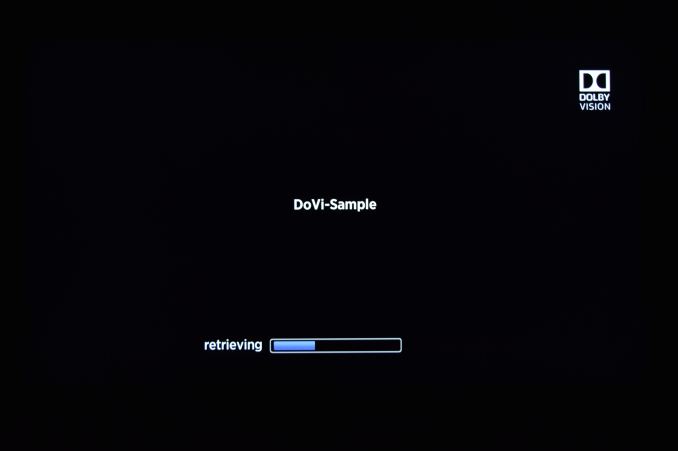

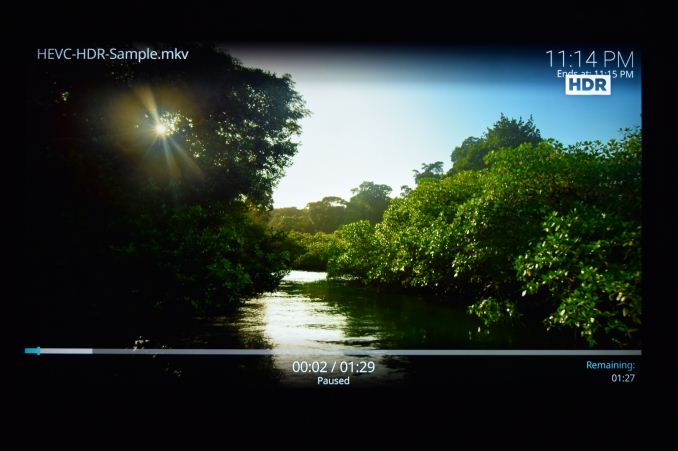
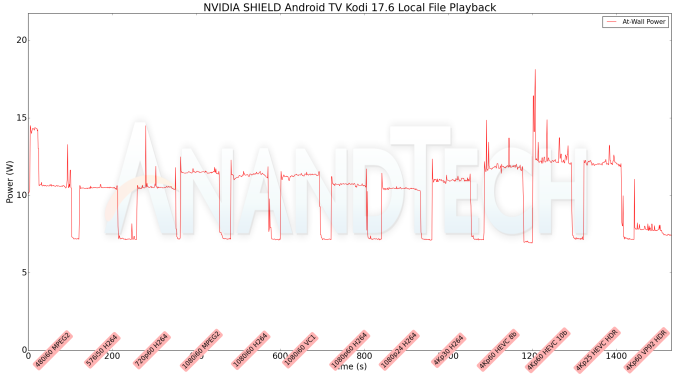
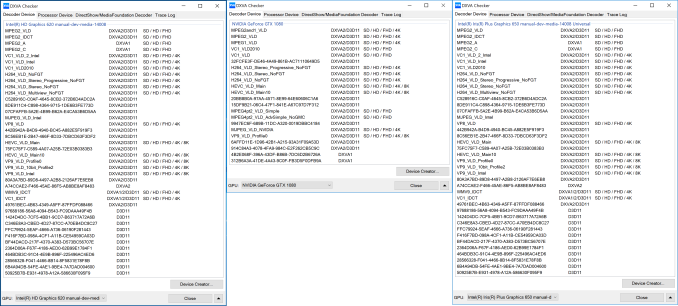
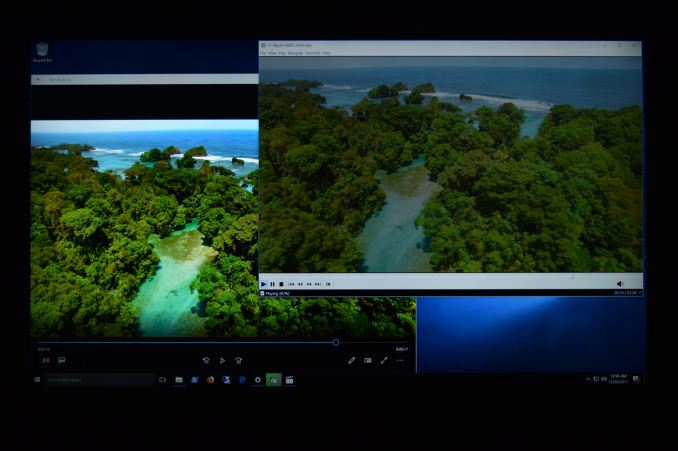
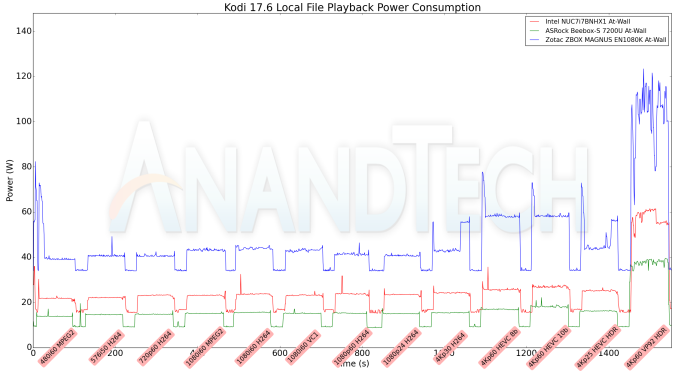
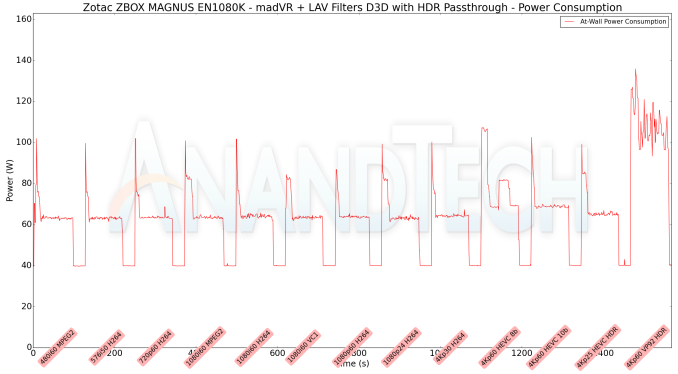
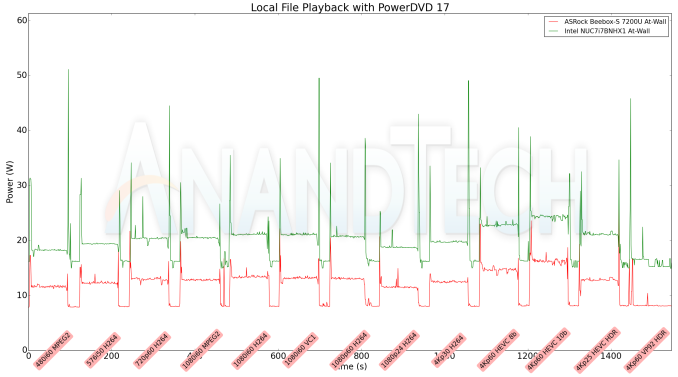








191 Comments
View All Comments
ebilg - Tuesday, December 26, 2017 - link
To avoid all the headaches with UHD Bly-rays you could just get an Xbox instead. The studios don't seem to care about 4K Blu-ray on PCs. Plus the Xbox also does Hulu in 4K.ddrіver - Tuesday, December 26, 2017 - link
It's obvious the "budget setup" isn't actually a budget setup because the guy just accepts to be "sponsored" with equipment that blows any budget: it goes from ~$470 to ~$1000. That's over $500 extra. On a budget! So who cares about the BR player? It can just be sponsored by somebody.@GaneshTS & AT what other budget builds can you do with expensive sponsored stuff? I was thinking on an article on how to get free gaming builds... from your parents.
ganeshts - Tuesday, December 26, 2017 - link
Dude, seriously? The only equipment that was sponsored was the Denon AVR, and it was clearly specified. Everything else was out of my own pocket (other than the PCs that come in for review on a revolving basis)ddrіver - Tuesday, December 26, 2017 - link
That wasn't about getting hidden stuff or anything like that. It was about adding $500 and still calling it a budget build. A $1000 receiver isn't part of any budget build. It doesn't make sense.Gasaraki88 - Wednesday, December 27, 2017 - link
So you want a home theater system but don't want to get an AV receiver? You complaining about a $500 receiver? That's the cheapest you can get that supports DV passthrough and all the other new tech. If you don't want good sound you don't need a receiver so you can subtract that out but then it not a "Home Theater" then.Icehawk - Wednesday, December 27, 2017 - link
Not even remotely true, plenty of recievers in the ~$400 range offer the sams functions. After my last two $800+ recievers crapped out after two years I will no longer put my money in them.Crazyeyeskillah - Thursday, December 28, 2017 - link
You are completely out of touch with your readers. There are plenty of options on the market that will deliver a great experience without dumping $500 into a receiver. While it's fun to piss away money on a home theater system, you don't have to blow all your money on something that won't give a perceivable benefit whatsoever to the average consumer. The extra $500 could make up the difference towards a 55" OLED display, or an entry level projector. Your priorities are clearly bias and deserve to be in question. Most of your articles are fair but this is really a preposterous entry without question.I would have honestly love to seen a review of some entry level projectors. Virtually everyone wants to know more about the bulbs, longevity, brightness, clarity, and other factors. Speakers are pretty much the no brainer of tech, they either work or they don't. If you want more channels just increase the blank.1 you have setup.
Even just building a really versatile box for future proof playback would have been sufficient. People tend to geek out on their displays in their own way.
FreckledTrout - Sunday, December 31, 2017 - link
@Crazyeyeskillah, I disagree. Any adults here who can afford an OLED TV would love a decent quality home theater which will cost at minimum $2000 but many people just don't know it. My nephew who is 28 has a good soundbar system and really didn't understand why I spend $2.5K on speakers and a receiver so we watched a movie, pearl harbor. When your company leans to duck the plane dropping bombs, priceless. Good home theater isn't something most people understand but once they have heard it they know what they are missing.SunnyHours - Wednesday, July 11, 2018 - link
There are other ways of having a decent speaker system without dishing out 500$US on a "home theater" receiver...especially if you don't plan on getting a decent set of Surround Sound speakers, which are not cheap...we are talking at least another 500$ up to 2000$ or more...and just for speakers.Instead, why not get a nice set of powered Bookshelf speakers like AudioEngine, Swan, HiVi, M-Audio, Kanto, Edifier and even Klipsch have good speakers that don't need a Receiver/Amplifier and generally have a 3.5mm cable so it's compatible with most anything, there are also some who do have RCA input(s). In this list you'll find all kinds of prices and whether you want a 2.0 speaker system or a 7.2 speaker system.
Also, another nice option if you have many things to connect, you can always just get a nice and simple 2.1 Sound System with a receiver (NAD, Yamaha, Denon, Harmon Kardon and others that don't come to mind should serve you well) and a pair of regular Bookshelf Speakers (Same brands mentioned before plus a couple others...just go to your biggest audio dealer close by and try them out before you buy them...if you can try both the receiver and speakers all the better!)
The 3rd option would be to go with Headphones!
If you want to head to head, speaker system vs Headphone system...of the same price, you'll always get way more sound for your money out of a simple headphone DAC/Amplifier combo and some Headphones or a DAC, headphone Amplifier and Headphones.
Whatever you do, please, do NOT encourage Bose. They sell overpriced stuff and it's just a really bad deal all around.
If you want more information and to ask questions to people who really know their stuff, head over to the Head-Fi Forums. They really specialize in headphones, but being Audiophiles usually means you'll also want good sounding speakers to be able to share it with others, and also to mix it up a little.
prerich - Friday, July 27, 2018 - link
Bravo!!!!